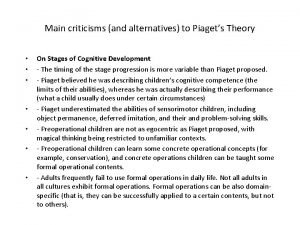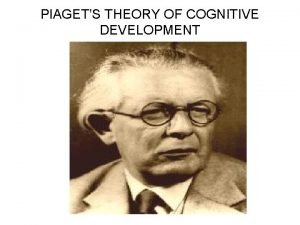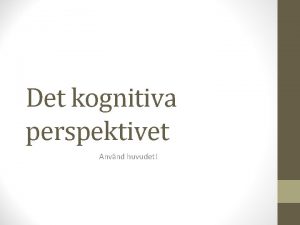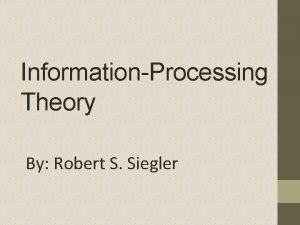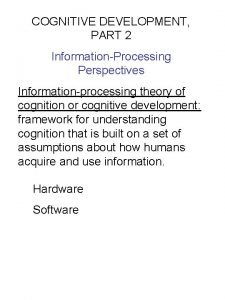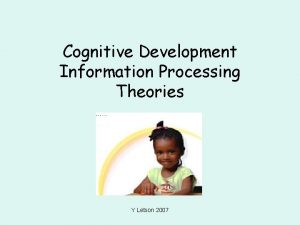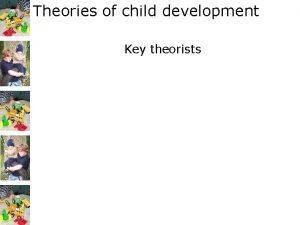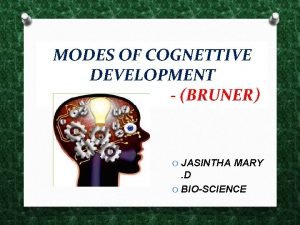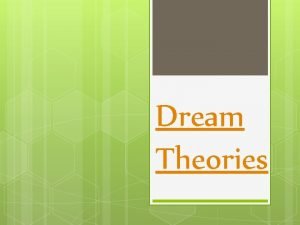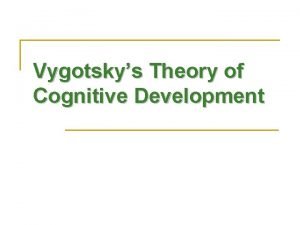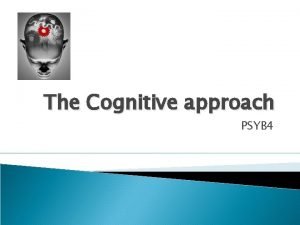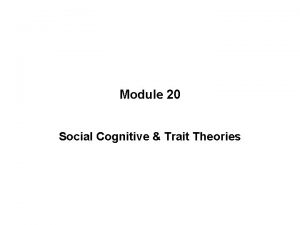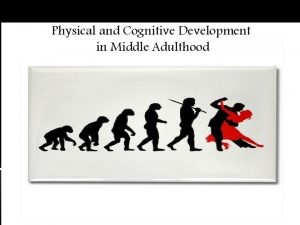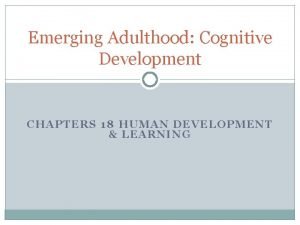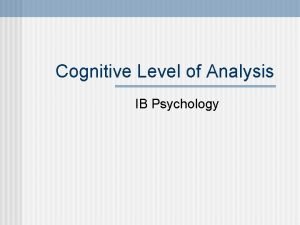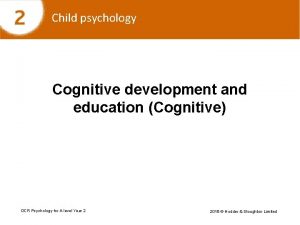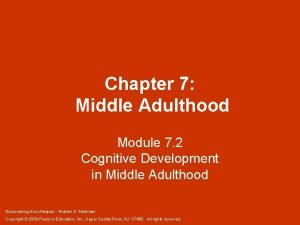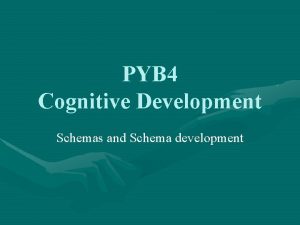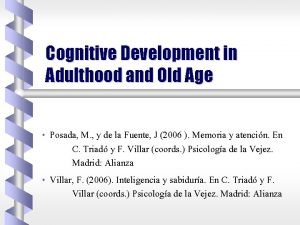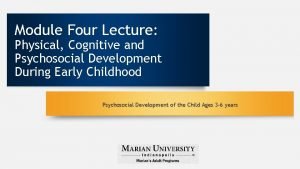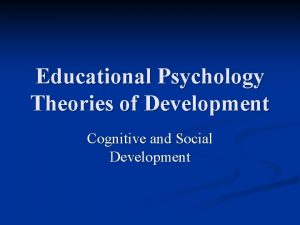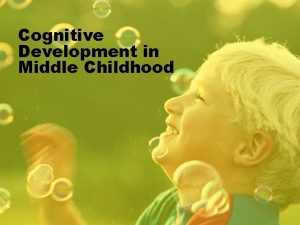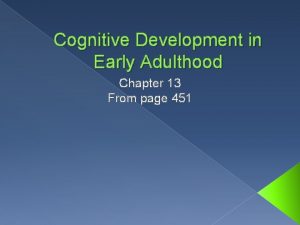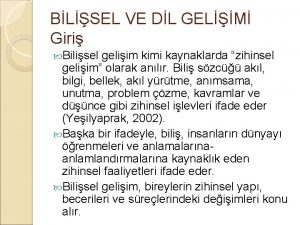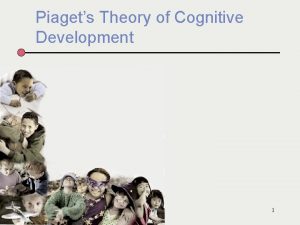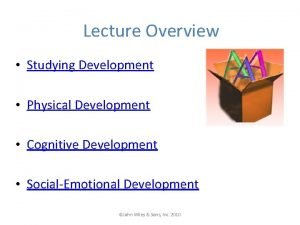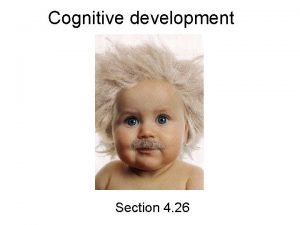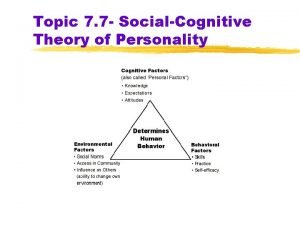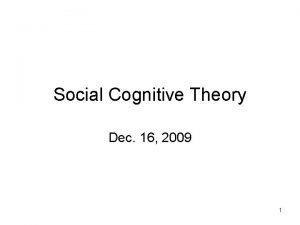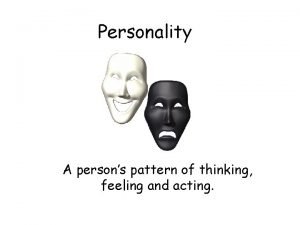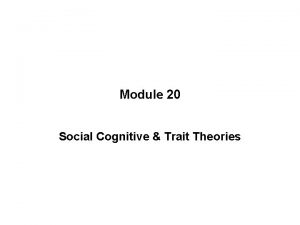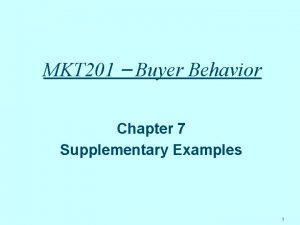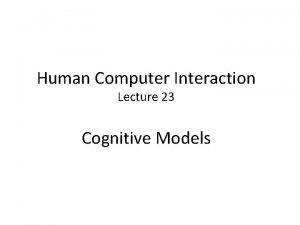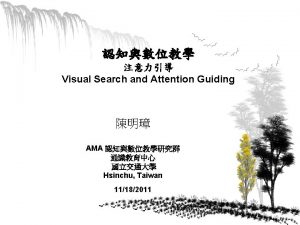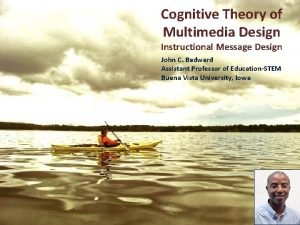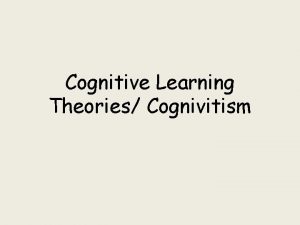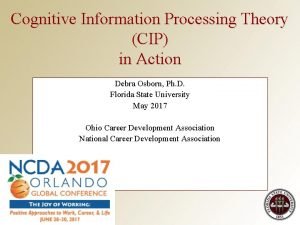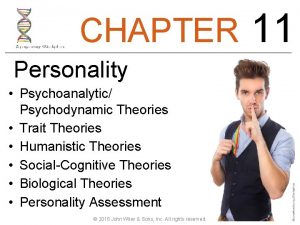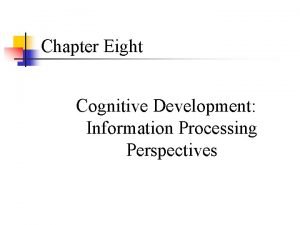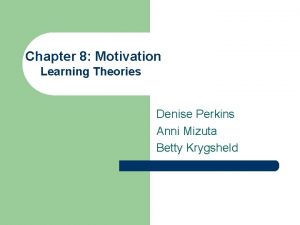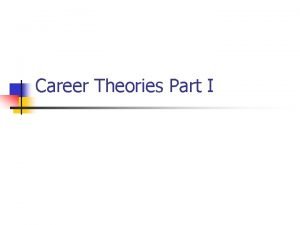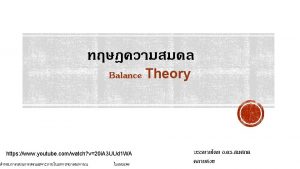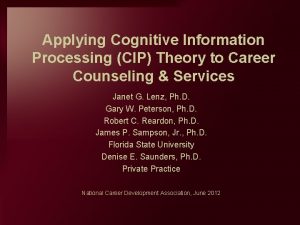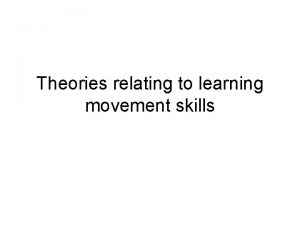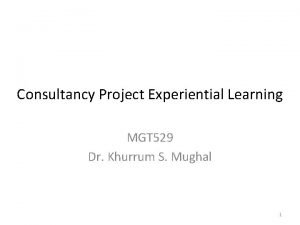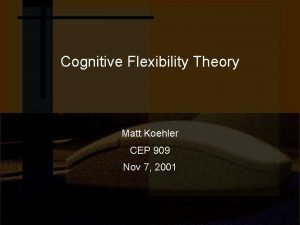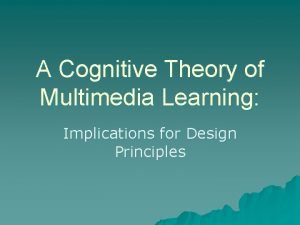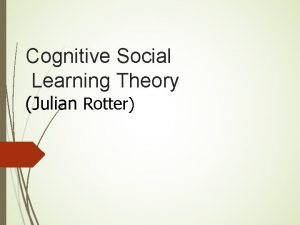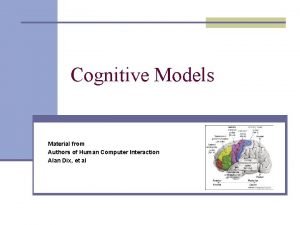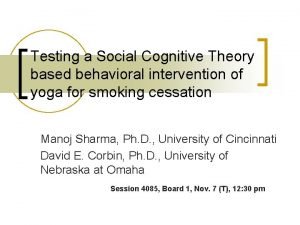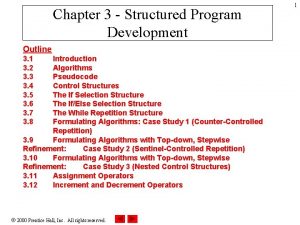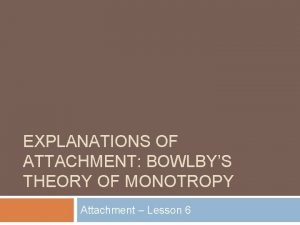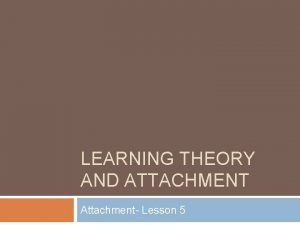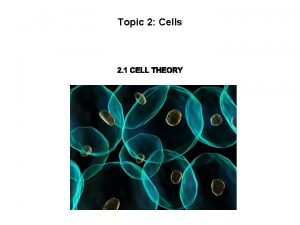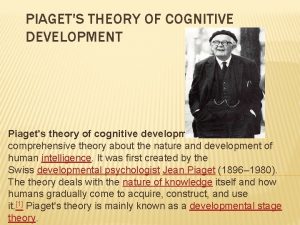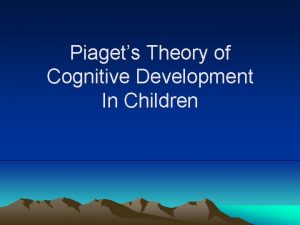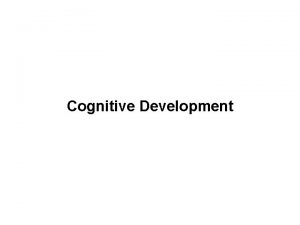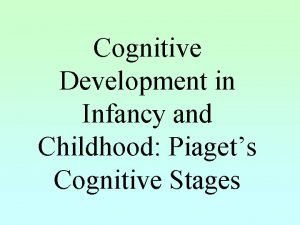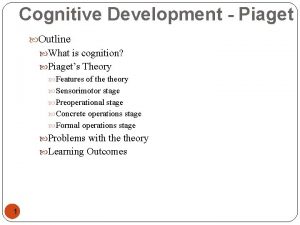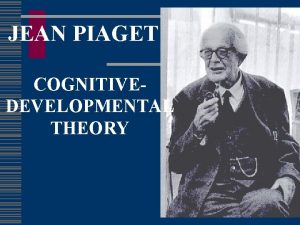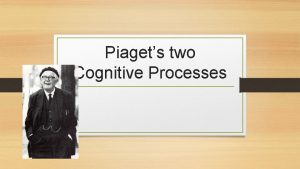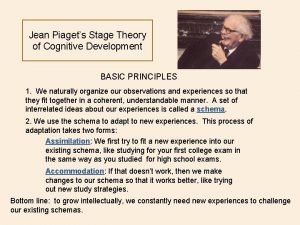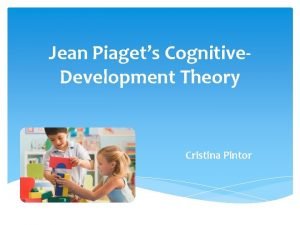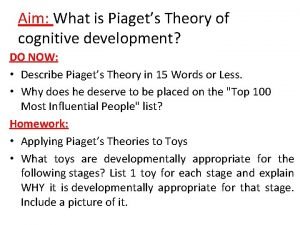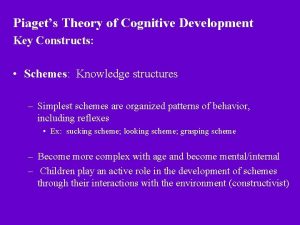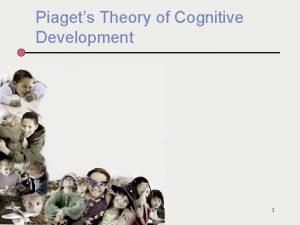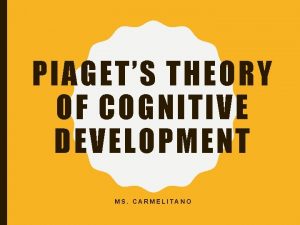PIAGETS THEORY OF COGNITIVE DEVELOPMENT OUTLINE Piagets Theory
















































































- Slides: 80

PIAGET’S THEORY OF COGNITIVE DEVELOPMENT





OUTLINE • • • Piaget’s Theory of Cognitive Development Influencing Factors Ø Maturation Ø Activity Ø Social Experience Ø Equilibration Basic Tendencies in Thinking Ø Schemes Ø Organization Ø Adaptation: ü Assimilation ü Accommodation Four Stages of Cognitive Development Ø Sensorimotor Stage Ø Preoperational Stage Ø Concrete Operational Stage Ø Formal Operations General Information Regarding the Stages Challenges to Piagetian Stage Theory

PIAGET’S THEORY OF COGNITIVE DEVELOPMENT(CD) • Jean Piaget (1896 -1980) was a Swiss researcher who, in his later years, concerned himself with studying children. • His research in the field of child development mainly focused on studying the development of language, reasoning and intelligence. 50 years of his life was spent studying these aspects, in children. • In his theory, Piaget believed that a child's intelligence was not determined at birth.

• After many years of observation, Piaget concluded that intellectual development is the result of the interaction of hereditary and environmental factors. As the child develops and constantly interacts with the world around him, knowledge is invented and reinvented. • His theory of intellectual development is strongly grounded in the biological sciences. He saw cognitive growth as an extension of biological growth and as being governed by the same laws and principles. • He argued that intellectual development controlled every other aspect of development - emotional, social, and moral.

• Jean Piaget devised a model describing how humans go about making sense of their world by gathering and organizing information. According to Piaget, this is an active cognitive process which lasts for some time in a person’s life. • It is important to examine Piaget’s ideas because they provide an explanation of the development of thinking from infancy to adulthood.

Piaget stressed that • children actively construct their own cognitive worlds; • information is not just poured into their minds from the environment; • two processes underlie an individual’s construction of the world: Ø organization Ø adaptation So, based on these views Piage tries to answer the following questions?

Ø How do we MAKE SENSE of the world? Ø What is the BASIC NATURE of CD theory? Ø What COGNITIVE PROCESSES are responsible for changes in a child’s development?

• CD is much more than the addition of new facts and ideas to an existing store of information. • Our thinking process change radically from birth to maturity because we constantly try to make sense of the world. How? • Piaget identified four influencing FACTORS: 1. Biological maturation 2. Activity Interaction 3. Social experience 4. Equilibration

MATURATION • The most important influencing factor on the way we make sense of the world. • It is the unfolding of the biological changes that are genetically programmed. • Parents and teachers have little impact on this aspect of CD except to be sure that children get the nourishment and care they need to be healthy.

ACTIVITY • As the child physically matures, this increases his ability to act on the environment and learn from it. • When a young child’s coordination is reasonably developed, he may discover principles about balance by his experience • The young child tests, observes and eventually organizes information altering his thinking process at the same time.

SOCIAL EXPERIENCE • As we develop, we are also interacting with people around us. • Our CD is influenced by social transmission, or learning from others. • Without social transmission we would need to reinvent all the knowledge already offered by our culture. • The amount of learning from social transmission varies according to the child’s stage of CD.

EQUILIBRATION • Organizing, assimilating and accommodating can be viewed as a kind of complex balancing act. • According to Piaget, actual changes in thinking take place through the process of equilibration: the act of searching for a balance.

• If we apply a particular scheme to an event or situation and the scheme works, then the equilibrium exists. • If the scheme does not produce a satisfying result, then disequilibrium exists, and we become uncomfortable. • This motivates us to keep searching for a solution through assimilation and accommodation and thus our thinking changes and moves ahead.

BASIC TENDENCIES IN THINKING 1. Schemes: Mental systems or categories of perception and experience. Ø Basic building blocks of thinking. They are organized systems, actions or thought that allow us to mentally represent or think about the objects or events in our world.

Ø It is a system through which the child tries to adjust to the environment and organize it. Schemes may be very small and specific. Ø For example, THE SUCKING THROUGH- A -STRAW SCHEME or RECOGNIZING A -ROSE-SCHEME. Or they may be larger and more general such as THE DRINKING SCHEME or THE CATEGORIZINGPLANTS SCHEME.

Ø As a person’s thinking processes become more organized and new schemes develop, behaviour also becomes more sophisticated and better suited to the environment.

2. Organization: Ongoing process of arranging information and experience into mental systems or categories. Ø People are born with a tendency to organize their thinking processes into psychological structures. These structures are our systems for understanding and interacting with the world. Ø Simple structures are continually combined and coordinated to become more sophisticated and thus more effective.

Ø Very young infants can either look at an object or grasp it when it comes in contact with their hands. They cannot coordinate looking and grasping at the same time. Ø As they develop, however, infants organize these two separate behavioral structures into a coordinated higher-level structure of looking at, reaching for, and grasping the object. Ø They can still use each structure separately as well.

3. Adaptation: People are born with the ability to adjust to their environment. Two bacis pocesses are involved in adaptation: a. Assimilation Ø This takes place when people use their existing schemes to make sense of events in their world. Ø It involves trying to understand something new by fitting it into what we already know. At times, we may have to distort the new information to make fit.


Ø For example, the first time many children see a lamb, they call it a dog. Or children who have never seen a sea lion fit this word in their existing knowledge of a lion and think that it is a lion which lives in the sea. They cannot realize that a sea lion could a completely be different sea animal.

b. Accommodation Ø This occurs when a person must change existing schemes to respond to a new situation. If new data cannot be made to fit any existing schemes, then more appropriate structures must be developed, or the existing ones must be adjusted.


Ø People adapt to their complex environments by using existing schemes whenever these schemes work, which is ASSIMILATION and by modifying and adding to their schemes when something new is needed, which is ACCOMMODATION. Ø In fact both processes are required most of the time. Let us give an example:

Ø Let us consider a circumstance in which an 8 -year old girl is given a hammer and nails to hang a picture on the wall. Ø She has never used a hammer before, but from experience and observation, she realizes that a hammer is an object to be held, that is swung by the handle to hit the nail, and that is usually swung a number of times. Ø Recognizing each of these things, she fits her behavior into information she already has (ASSIMILATION).

Ø However, the hammer is heavy, so she holds it near the top. She swings too hard and the nail bends, so she adjusts the pressure to her strikes. Ø These adjustments reveal her ability to change her conception of the world slightly (ACCOMMODATION). Ø Even using an established pattern such as sucking through a straw may require some accommodation if the straw is of a different size or length than the type you are used to.

Ø There also times when neither assimilation nor accommodation is used. If people encounter something that is too unfamiliar, they may ignore it. Ø Experience is filtered to fit the kind of thinking a person is doing at a given time. Ø For example, if you overhear a conversation in a foreign language, you probably won’t try to make sense of the exchange unless you have some knowledge of the language.

FOUR STAGES OF COGNITIVE DEVELOPMENT • Piaget’s four stages of CD are: q The Sensorimotor Stage: Infancy q The Preoperational Stage: Early Childhood to Early Elementary Years q The Concrete-Operational Stage: Later Elementary to Middle School Years q Formal Operations: Junior and Senior High

PIAGET’S STAGES

THE SENSORIMOTOR STAGE • The earliest period is called sensorimotor stage because the child’s thinking involves the coordination of SENSES and MOTOR activity, such as seeing, hearing, tasting, moving, touching and so on.

The Main Characteristics of Sensorimotor Stage ØIt is an ability to organize and coordinate sensations with physical movements. ØIt consists of six substages of cognitive development. ØIt is non symbolic through most of its duration. ØObject permanence develops at this stage. ØGoal-directed actions begin here.

• The sensorimotor stage lasts from birth to about 2 years of age. The stage begins with the newborn, who has little more than reflexes to coordinate senses with actions. The age ends with the 2 -year old, who has complex sensorimotor patterns and is beginning to adopt a primitive symbol system. However this stage is considered to be nonsymbolic through most of its duration. • The sensorimotor stage is divided into six substages, which involve qualitative changes in sensorimotor organization. Within a given substage, there may be different schemes - sucking, rooting, and blinking in substage 1, for example.

• The six substages of sensorimotor development are: üSimple reflexes üFirst habits and primary circular reactions üSecondary circular reactions üCoordination and secondary circular reactions üTertiary circular reactions, novelty, and curiosity üInternalization of schemes

• Object Permanence, is Piagetian term for one of an infant’s most important accomplisments: understanding that objects and events continue to exist in the environment even when they cannot directly be seen, heard, or touched. • As most parents discover, before infants develop object permanence, it is relatively easy to take something away from them. The trick is to distract them and remove the object while they are not looking- out of sight, out of mind.

• The older infant who searches for the ball that has rolled out of sight indicates an understanding that objects still exist when they are not in view. • As seen in the picture, even though the blue ball disappears out of the sight of the baby, he doesn’t search for it.

• The principle way that object permanence is studied is by watching infants’ reactions when an attractive object or event disappears. • If they show no reaction, it is assumed they believe the object no longer exists. • By contrast, if they are surprised at the disappearance and search for the object, it is assumed they believe it continues to exist.

• Recent reseach, however suggests that very young infants may know that the object still exists, but they do not have the memory skills to hold on the location of the object or the motor skills to coordinate a search.

• A second major accomplisment in this period is the beginning of logical, GOAL-DIRECTED ACTIONS. • Let us give an example to explain this aspect: Think of a familiar container toy for babies. A 6 -month old baby is likely to become frustrated trying to get to the toys inside. But an older child who has mastered the basics of the sensorimoor stage will be able to deal with the toy in an orderly fashion by building a container toy scheme: 1. get the lid off 2. turn the container upside down 3. shake if the items jam 4. watch the items fall • Separate lower level schemes have been organized into higher level schemes to achieve a goal.

THE PREOPERATIONAL STAGE • This period is the early childhood and the early elementary years. The cognitive world of the preschool child is CREATIVE, FREE and FANCIFUL. The imagination of preschool children works over-time and their mental grasp of the world improves • The preoperational stage stretches from app. the age of 2 to the age of 7. • Preoperational thought is anything but a convenient waiting period for concrete operational thought, although the label PREOPERATIONAL emphasizes that the child at this stage does not yet think in an operational way.

The Main Characteristics of the Preoperational Stage Ø Inability to engage in operations, can’t mentally reverse actions: lacks conservation skills Ø More symbolic than sensorimotor thought Ø Egocentric: inability to distinguish between own perspective and someone else’s Ø Intuitive rather than logical

• Operations are internalized sets of actions that allow children to do mentally what before they had done phsically. • The hallmark of the preoperational stage is sparse and logically inadequate mental operations. • In other words, they are actions a person carries out by thinking instead of performing.

• The stage after sensorimotor is called preoperational, because the child has not yet mastered these mental operations but is moving toward mastery. • Preoperational thought can be subdivided into two substages: ØSymbolic function substage ØIntuitive thought substage

• Symbolic function substage is the first substage of the preoperational thought. It occurs roughly between the ages of 2 and 4. • In this substage, the young child gains the ability to mentally represent an object that is not present. This type of thinking involves making action schemes SYMBOLIC. • The ability to form and use symbols- words, gestures, signs, images, and so on- is a major accomplishment of the period and moves children closer to mastering the mental operations of the next stage.

• This ability to work with symbols, such as using the word car or a picture of a car to represent a real car that is not actually present, is called the SEMIOTIC FUNCTION. They draw pictures to represent people, houses, dogs, clouds, and so on. • The child’s earliest use of symbols is in pretending or miming. • Children who are not yet able to talk will often use action symbols-pretending to drink from an empty cup or touching a comb to their hair, showing that they know what each object is for. • Their schemes are becoming more general and less tied to specific actions. e. g. Eating scheme in playing house.

• During this substage, we also see the rapid development of the symbol of language. Between the ages of 2 and 4, most children enlarge their vocabulary from about 200 to 2000 words. • Egocentrism is an important feature of preoperational thought. According to Piaget, children tend to see the world and experiences of others from their own viewpoint. • Egocentrism doesn’t mean selfish. It simply means children often assume that everyone else shares their feelings, reactions, and perspectives. • For example, if a little boy at this stage is afraid of dogs, he may assume that all children share this fear. • Another example is the positions of the right-left hands when facing the children. They center on their own perceptions.

• Piaget and Inhelder studied young children’s egocentrism by devising the three mountains task. The child walks around the model of the mountains and becomes familiar with what they look like from different perspectives and can see that there are different objects on the mountains. Then he is seated on one side of the table. The experimenter moves a doll to different locations around the table.

• At each location, the experimenter asks the child to select the one photo that most accurately reflects the view the doll is seeing. • Children in this stage often pick their view from where they are sitting rather than the doll’s view. • The conclusion is that perspective taking does not seem to develop uniformly in preschool children.

• Animism is another aspect of preoperational thought. It is the belief that inanimate objects have lifelike qualities and are capable of action. • For example, a child plays with a doll and treats it like a real person. In a way this is like using their imagination. • A young child might say that tree pushed the leaf off and it fell down or the sidewalk made me fall down.

• The intuitive thought substage is the second substage of preoperational thought, occuring between 4 and 7 years of age. • In this substage, children begin to use primitive reasoning and want to know the answers to all sorts of questions. Piaget called this time period intuitive because, children say they know something but know it without the use of rational thinking. • This substage can be marked by reversible thinking, which is thinking backward, from the end to the begining.

• As the child moves through the intuitive thought stage, the developing ability to think about objects in symbolic form remains limited to thinking in one direction only, or using one way logic. It is very difficult for the child to think backwards or to reverse the steps in a task. • Reversible thinking is involved in many tasks such as the conservation of matter.

• Conservation is the principle that the amount of number of something remains the same even if the arrangement or appearance is changed, as long as nothing is added or nothing is taken away. • A classic example with conservation can be explained in the task using two identical glasses with the same amount of water. One amount is poured into a narrower/taller glass.

• When the child is asked which glass have more water, the preoperational child’s reply is the taller one. • Piaget’s explanation is that the child is focusing, or centering attention on the dimension of height. The child has difficulty considering more than one aspect of the situation at a time, or decentering. • The preoperational child cannot understand that increased diameter compensates for decreased height, because this would require taking into account two dimensions at once.

Ø Conservation of Number and Mass

• As shown in the images above, a child is presented with two identical rows of objects . While one row is lengthened without any change in the number of objects, the preoperational child states that the first row has more objects and rows are not equivalent. The appearance of the objects gives the wrong impression about them. Children’s decisions are dominated by their perceptions.

• Conservation does not happen simultaneously in all subject areas. Children can understand conservation of numbers around age 5 -6, and understand conservation of substance, or mass around age 7 -8 • Some dimensions of conservation that children show are number, matter, length, volume, and area. • Another characteristic of preoperational children is that they ask a number of questions. Their earliest questions appear around the age of 3 and the questions give clues about their mental development and reflect intellectual curiosity.

THE CONCRETE OPERATIONAL STATE • A concrete operation is a reversible mental action on real, concrete objects. • The stage generally represents the elementary grade years. The concrete operational child begins to think logically. • Operations are associated with personal experience. Operations are in concrete situation, but not in abstract manipulation.

• Children at Concrete Operational Stage

The Main Characteristics of Concrete Operational Thought Ø Can use operations mentally reversing action; shows conservation skills Ø Logical reasoning replaces intuitive reasoning, but only in concrete circumstances Ø Not abstract: can’t imagine steps in algebraic equation, for example. Ø Classification skills: can divide things into sets and subsets and reason about their interrelations.

• Concrete operations allow children to classify several classes into a bigger group or to combine a number of classes in any order. • For example, when shown a family tree of four generations the concrete operational child can classify the members vertically, horizontally or up and down and across. • Although objects are moved or reordered, no change takes place. • In addition, concrete operations allow children to order objects in terms of more than one dimension.

• Children at the concrete operational stage can solve conservation tasks. The operational thought is reversible. Once children have learnt to conserve, they learn about 'reversibility'. • This means that they learn that if things are changed, they will still be the same as they used to be. • For example, they learn that if they spread out the pile of blocks, there are still as many there as before, even though it looks different! • The concrete operational child can operate an action, and then go back to the original condition. For instance, 3 + 2 = 5 and 5 – 2 = 3

FORMAL OPERATIONS • The formal operational stage begins around age 11 and is fully achieved by age 15, bringing with it the capacity for abstraction. • This permits adolescents to reason beyond a world of concrete reality to a world of possibilities and to operate logically on symbols and information that do not necessarily refer to objects and events in the real world.

• This stage is characterized by an increased independence for thinking through problems and situations. • Adolescents should be able to understand pure abstractions, such as philosophy and higher math concepts. • During this age, children should be able to learn and apply general information needed to adapt to specific situations. • They should also be able to learn specific information and skills necessary for an occupation.

• The major component of the passage through adolescence is the cognitive transition. • Compared to children, adolescents think in ways that are more advanced, more efficient, and generally more complex. This ability can be seen in five ways: • First, during adolescence individuals become better able than children to think about what is possible, instead of what is real. Ø Whereas children's thinking is oriented to the here and now—that is, to things and events that they can observe directly—adolescents are able to consider what they observe against a backdrop of what is possible; they can think hypothetically.

• Second, during the passage into adolescence, individuals become better able to think about abstract ideas. For example, adolescents find it easier than children to comprehend the sorts of higher-order, abstract logic inherent in puns, proverbs, metaphors, and analogies. Ø The adolescent's greater facility with abstract thinking also permits the application of advanced reasoning and logical processes to social and ideological matters. This is clearly seen in the adolescent's increased facility and interest in thinking about interpersonal relationships, politics, philosophy, religion, and morality.

• Third, during adolescence individuals begin thinking more often about the process of thinking itself, or metacognition. Ø As a result, adolescents may display increased introspection and self-consciousness. Ø Although improvements in metacognitive abilities provide important intellectual advantages, one potentially negative byproduct of these advances is the tendency for adolescents to develop a sort of egocentrism, or intense preoccupation with the self.

• A fourth change in cognition is that thinking tends to become multidimensional, rather than limited to a single issue. Ø Whereas children tend to think about things one aspect at a time, adolescents can see things through more complicated lenses. Ø Adolescents describe themselves and others in more differentiated and complicated terms and find it easier to look at problems from multiple perspectives.

Ø Being able to understand that people's personalities are not one-sided or that social situations can have different interpretations depending on one's point of view permits the adolescent to have far more sophisticated and complicated relationships with other people.

• Finally, adolescents are more likely to see things as relative, rather than absolute. Ø Children tend to see things in absolute terms—in black and white. Ø Adolescents, in contrast, tend to see things as relative. They are more likely to question others' assertions(claims) and less likely to accept facts as absolute truths. Ø This increase in relativism can particularly annoy parents, who may feel that their adolescent children question everything just for the sake of argument. Difficulties often arise, for example, when adolescents begin seeing their parents' values as excessively relative.

The Main Characteristics of Formal Operational Thought v Thus, on the bases of all the aspects given above we can summarize the main characteristics of the formal operational thought as follows: Ø Abstract: can solve abstract algebraic equations Ø Idealistic: ideal characteristics of themselves, others, and the world Ø Logical: hypothetical-deductive

General Information Regarding The Stages v These four stages have been found to have the following characteristics: Ø Although the timing may vary, the sequence of the stages does not. Ø Universal (not culturally specific) Ø Generalizable: the representational and logical operations available to the child should extend to all kinds of concepts and content knowledge Ø Stages are logically organized wholes Ø Hierarchical nature of stage sequences (each successive stage incorporates elements of previous stages, but is more differentiated and integrated) Ø Stages represent qualitative differences in modes of thinking, not merely quantitative differences.

Challenges to Piagetian Stage Theory • Piagetians accounts of development have been challenged on several grounds. First, as Piaget himself noted, development does not always progress in the smooth manner his theory seems to predict. • More broadly, Piaget's theory is 'domain general', predicting that cognitive maturation occurs concurrently across different domains of knowledge (such as mathematics, logic, understanding of physics, of language, etc). • However, more recent cognitive developmentalists have been much influenced by trends in cognitive science away from domain generality and towards domain specificity or modularity of mind, under which different cognitive faculties may be largely independent of one another and thus develop according to quite different time-tables.

• In this vein, many current cognitive developmentalists argue that rather than being domain general learners, children come equipped with domain specific theories, sometimes referred to as 'core knowledge', which allows them to break into learning within that domain. • For example, even young infants appear to understand some basic principles of physics (e. g. that one object cannot pass through another) and human intentionality (e. g. that a hand repeatedly reaching for an object has that object, not just a particular path of motion, as its goal). These basic assumptions may be the building block on which more elaborate knowledge is constructed.

SORULAR • Her gün ortalama 5 -6 kişinin trafik kazasında öldüğü, onlarca insanın engelli hale geldiği bir ülkede, derslerde ve medyada ne kadar anlatılırsa anlatılsın, insanlar yine de trafik kurallarına uymamaktadır. Hatta bu olumsuz durumlar kişinin yakınındaki insanların başına gelse bile kişi kurallara uymamaya devam etmektedir. Ta ki kendi başına bir kaza gelinceye kadar… Burada, öğretmenin ve model almanın etkisiz kaldığı görülmektedir. • Bu durum gelişim psikolojisinin hangi kavramı ile açıklanabilir? • A) Olgunlaşma B) Deneyim C) Büyüme • D) Kritik dönem E) Kalıtım

REFERENCES • Woolfolk, A. (2005). Educational Psychology. Boston: Pearson, Allyn and Bacon • Santrock, J. W. (1996). Child Development. Chicago: Brown and Benchmark. • Senemoğlu, N. (2004). Gelişim, Öğrenme ve Öğretim Kuramdan Uygulamaya. Ankara: Gazi Kitapevi • ehlt. flinders. edu. au/…/images/basketball. gif • www. mc. maricopa. edu/. . . /Ear_Chil/Erly. Child. html • www. answers. com/topic/cognitive-development • www. sk. com. br/sk-piage. html • www. psychology 4 a. com/playpic 02. gif • http: //projects. coe. uga. edu/epltt/images/b/b 8/Piaget_1. jpg

THANK YOU FOR LISTENING TO ME Ass. Prof. Dr. Gülden MERSİNLİGİL Çağ University Adana and Mersin TURKEY

Cognitive Theories §Gestalt theory §Information processing theory §Metacognitive theory §Problem solving theory §Piaget’s cognitive development theory §Vygotsky’s cultural-historical theory of psychological development
 Criticisms of piagets theory
Criticisms of piagets theory Conclusion of piaget's theory
Conclusion of piaget's theory Biologiska perspektivet grundare
Biologiska perspektivet grundare Cognitive and non cognitive religious language
Cognitive and non cognitive religious language Cognitive learning theory by jerome bruner
Cognitive learning theory by jerome bruner Robert siegler theory
Robert siegler theory Piaget information processing theory
Piaget information processing theory Information processing theory of cognitive development
Information processing theory of cognitive development What is gesell's theory of development
What is gesell's theory of development Transductive reasoning psychology
Transductive reasoning psychology Piaget's preoperational stage
Piaget's preoperational stage Bruner's theory of cognitive development
Bruner's theory of cognitive development Activation-synthesis theory dreams
Activation-synthesis theory dreams Examples of guided participation
Examples of guided participation Piaget's theory of cognitive development
Piaget's theory of cognitive development Cognitive essay
Cognitive essay Trait theory vs social cognitive theory
Trait theory vs social cognitive theory Quote sandwich examples
Quote sandwich examples Intellectual development middle adulthood
Intellectual development middle adulthood Reflective and relativistic thinking
Reflective and relativistic thinking Physical development of late childhood
Physical development of late childhood Module 47 infancy and childhood cognitive development
Module 47 infancy and childhood cognitive development Intellectual development in later adulthood
Intellectual development in later adulthood Emerging adulthood cognitive development
Emerging adulthood cognitive development Ib psychology cognitive level of analysis
Ib psychology cognitive level of analysis Cognitive development characteristics
Cognitive development characteristics Cognitive ocr
Cognitive ocr Cognitive development middle adulthood
Cognitive development middle adulthood Labouvie-vief pragmatic thought
Labouvie-vief pragmatic thought Schema cognitive development
Schema cognitive development Early childhood is ____ for language learning
Early childhood is ____ for language learning Psicometric chart
Psicometric chart Conclusion of cognitive development
Conclusion of cognitive development Define physical cognitive and psychosocial development
Define physical cognitive and psychosocial development How did vygotsky view cognitive development? *
How did vygotsky view cognitive development? * Language development in middle childhood
Language development in middle childhood Commitment within relativistic thinking
Commitment within relativistic thinking Pendulum problem piaget
Pendulum problem piaget Psychsim 5 cognitive development
Psychsim 5 cognitive development Piaget's stages of cognitive development
Piaget's stages of cognitive development Vygotsky theory
Vygotsky theory 3 stages of prenatal development
3 stages of prenatal development Cognitive development
Cognitive development Module 47 infancy and childhood cognitive development
Module 47 infancy and childhood cognitive development Cognitive development quiz
Cognitive development quiz Chapter 5 cognitive development in infancy and toddlerhood
Chapter 5 cognitive development in infancy and toddlerhood Cognitive theory personality
Cognitive theory personality Social cognitive theory motivation
Social cognitive theory motivation Social cognitive theory of personality examples
Social cognitive theory of personality examples Social cognitive theory of personality examples
Social cognitive theory of personality examples Cognitive dissonance theory example
Cognitive dissonance theory example Cognitive complexity theory in hci
Cognitive complexity theory in hci Beck cognitive theory
Beck cognitive theory Cognitive theory of multimedia learning
Cognitive theory of multimedia learning Instructional message design
Instructional message design Cognitive learning theory
Cognitive learning theory Cip model
Cip model 16 source traits
16 source traits Information processing theory by atkinson and shiffrin
Information processing theory by atkinson and shiffrin Social cognitive theory motivation
Social cognitive theory motivation Cognitive learning theory in marketing
Cognitive learning theory in marketing Cognitive information processing
Cognitive information processing Cognitive dissonance theory
Cognitive dissonance theory Chapter 3 applying learning theories to healthcare practice
Chapter 3 applying learning theories to healthcare practice Cognitive information processing theory career
Cognitive information processing theory career Cognitive load theory sweller
Cognitive load theory sweller Cognitive theory of learning movement skills
Cognitive theory of learning movement skills Cognitive learning theory
Cognitive learning theory Cognitive flexibility theory
Cognitive flexibility theory Principleu
Principleu Basic prediction formula rotter
Basic prediction formula rotter What is bnf in hci
What is bnf in hci Social cognitive intervention
Social cognitive intervention Appraisals in lazarus theory of emotion
Appraisals in lazarus theory of emotion Program development outline
Program development outline Bowlby theory
Bowlby theory Outline bowlby's theory of attachment 6 marks
Outline bowlby's theory of attachment 6 marks Outline and evaluate the learning theory of attachment
Outline and evaluate the learning theory of attachment Outline one therapeutic use of stem cells
Outline one therapeutic use of stem cells Definition community development
Definition community development Development that ended much development crossword
Development that ended much development crossword
